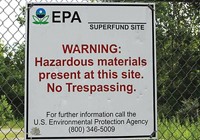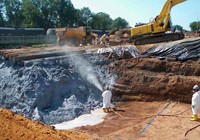Advertisement
Grab your lab coat. Let's get started
Welcome!
Welcome!
Create an account below to get 6 C&EN articles per month, receive newsletters and more - all free.
It seems this is your first time logging in online. Please enter the following information to continue.
As an ACS member you automatically get access to this site. All we need is few more details to create your reading experience.
Not you? Sign in with a different account.
Not you? Sign in with a different account.
ERROR 1
ERROR 1
ERROR 2
ERROR 2
ERROR 2
ERROR 2
ERROR 2
Password and Confirm password must match.
If you have an ACS member number, please enter it here so we can link this account to your membership. (optional)
ERROR 2
ACS values your privacy. By submitting your information, you are gaining access to C&EN and subscribing to our weekly newsletter. We use the information you provide to make your reading experience better, and we will never sell your data to third party members.
Pollution
Should the chemical industry have to prove it can pay for pollution cleanup?
No, US EPA says in proposal
by Cheryl Hogue
February 24, 2020

For decades, financially struggling companies abandoned polluted areas, leaving others to foot the cleanup bill. Today, things are different, US chemical makers say. They point to modern environmental practices superimposed on years of adhering to pollution-control laws to make the case that they have cleaned up their act.
The Trump administration agrees with these companies. It plans to forego a federal requirement ensuring that chemical manufacturers can cover costs of cleanup from their operations.
But environmental activists like the Sierra Club’s Jane Williams say things haven’t changed much since the 20th century. Williams points to the per- and polyfluoroalkyl substances (PFAS) released from a Chemours factory formerly owned by DuPont in Fayetteville, North Carolina. The chemicals have spread downstream of the plant, tainting surface and groundwater as well as soil.
Chemours says it doesn’t have enough money to fix the mess. The company is suing DuPont—which spun off Chemours in 2015 and then merged with Dow later that year—seeking more money for the cleanup. A new version of DuPont emerged in 2019 when DowDuPont split into three corporations.
Williams and others back the idea that the government should require companies, including chemical manufacturers, to ensure they can cover costs of cleaning up contamination from their operations.
The concept of making polluters—not taxpayers—foot the bill for cleanup dates to a 1980 US federal law. The Comprehensive Environmental Response, Compensation, and Liability Act, commonly called the Superfund law, addresses liability and cleanup of land contaminated with hazardous waste.
This legislation was the US Congress’s response to the discovery in the late 1970s of leaking hazardous waste sites containing tons of toxic chemicals, most notably the notorious Love Canal neighborhood of Niagara Falls, New York. The former Hooker Electrochemical Co.—later purchased by Occidental Chemical—had disposed of chemical waste at that site in the 1940s and 1950s.
The Superfund act contains a provision that instructs the EPA to require industries that handle hazardous substances to have the financial means to clean up any toxic releases. The mechanism for financial assurance essentially would be bonds guaranteeing companies have money to rectify pollution they cause.
While the EPA implemented most of the Superfund law, the agency did not act on the financial assurances provision.
Then in 2005, the Government Accountability Office (GAO), the nonpartisan investigative arm of Congress, warned that costs of cleaning up Superfund and other hazardous waste sites were increasingly shifting from corporations to taxpayers. To meet the Superfund law’s goal that polluters pay for cleanup, the GAO recommended that the EPA “expeditiously implement” the mandate for financial assurance regulations.
The agency still didn’t act.
In 2008, a group of environmental advocacy organizations, including the Sierra Club, sued the EPA. A federal trial court in 2009 ordered the EPA to implement the Superfund financial assurance provision. Later that year, the agency targeted the hardrock mining sector as its priority for a financial assurance rule. The environmental group Earthworks says hardrock mining for minerals is the nation’s largest source of hazardous pollutants and presents a significant risk to public health from spills, untreated discharges, and unreclaimed mines.
The EPA in 2010 identified three more industries that it would consider for financial responsibility requirements: chemical manufacturing, petroleum and coal products, and electricity generation. But the agency again didn’t act until environmental groups took it to court once more and a judge set deadlines for agency actions.
As the Obama administration wound down in late 2016, the EPA proposed Superfund financial responsibility requirements for hardrock mining. The agency also said it would issue similar proposals for the other three sectors. Under deadlines set by the court, the EPA had until December 2022 to propose a rule for the chemical industry and until December 2024 to make a final decision.
This timeline handed the Trump administration the opportunity to take final action on all four industries.
Some federal and state agencies and industry opposed the hardrock mining proposal, saying it was unnecessary because of existing federal and state regulations and modern mining practices. Agreeing with these arguments, the Trump EPA made a final determination in December 2017 that the agency would not issue financial responsibility requirements for hardrock mining because they weren’t needed.
Environmental groups challenged the decision. In July 2019, a panel of three federal appeals court judges backed the rule and the EPA’s reasoning behind it. That gave the Trump EPA firm legal footing to forestall financial assurance plans for the other sectors.
Under a proposal the EPA issued in late February, the agency wouldn’t impose financial requirements on chemical makers. The agency will accept public comments on the plan before taking final action, which is likely to happen later this year.
“After careful analysis, EPA has concluded that the existing regulatory programs and current industry practices that have been put in place over the last four decades already address the financial risk of the government having to fund cleanups from operating chemical manufacturing facilities,” the agency says in a fact sheet on its proposal.
Environmental activists oppose the EPA plan. The agency’s proposal, the Sierra Club’s Williams tells C&EN, paves the way for industry to continue abandoning polluted sites, which Williams calls “a wealth transfer from the polluted to the polluter.”
The American Chemistry Council, the largest lobbying group of US chemical manufacturers, applauded the news. “Federal and state programs, along with modern operating procedures, have significantly reduced the risk of taxpayer-funded cleanup efforts,” ACC says in a statement provided to C&EN. “We’re pleased that EPA does not intend to pursue duplicative new regulations that would increase costs for chemical manufacturers without environmental benefit.”
The agency will accept public comments on the plan before taking final action, which is likely to happen later this year.




Join the conversation
Contact the reporter
Submit a Letter to the Editor for publication
Engage with us on Twitter